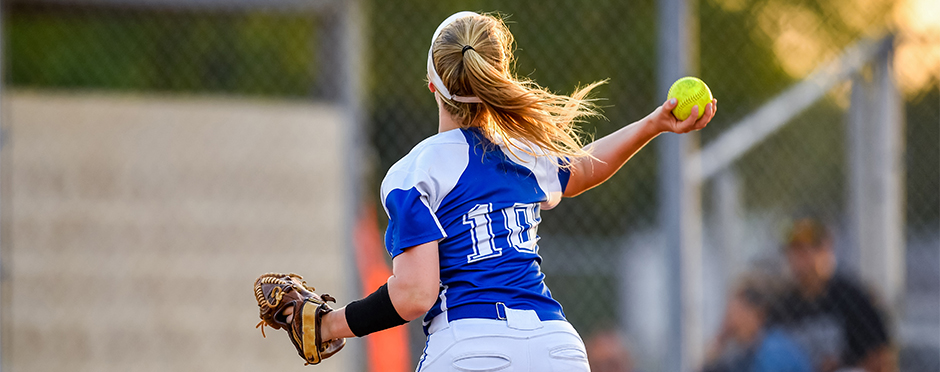
6 Warm-Up Stretches for Overhead Athletes Before a Game
Leave a Comment“Go get your arm warmed up!” This is a phrase I hear all the time for overhead athlete sports, whether it’s the relief pitcher in baseball, the center fielder in softball, the ACE server in volleyball, or the star QB. This is solid advice; it’s never a good idea to go into aggressive overhead activity without a proper warm-up, but what makes a good warm-up? That can be a very loaded question! Fortunately, by understanding the anatomy of the shoulder and the requirement by its muscles to work optimally overhead, it can be simple to get an athlete ready for action and, more importantly, lower their risk for injury.
Here are my six go-to “primers” to prepare your athlete for overhead action.
1.) Stretch out those lats!
Many people think about stretching their pecs out when their shoulders are tight. However, they tend to forget about their latissimus dorsi, or “lats.” This broad muscle connects our arm to our hips, and it can get incredibly tight if you sit at a desk all day with bad posture. When this muscle gets tight, it decreases our ability to externally rotate (cocking phase of overhead movement) our shoulder effectively, setting the athlete up for a poor position to generate power and increasing their chance of injury.
How can you stretch your lats? Remember to pack a thick monster band with you and loop it onto something over your head. A pull-up rack, riser stand rails, or softball/baseball fences are great places. With your palm facing up, grab the bottom of the band. From there, let your arm drift overhead, drop your hips and rotate the ribs of your stretched arm outward. You may place your opposite hand on the ribs of the side you are stretching and add a touch more downward pressure if you want. Hold this position for 15 to 20 seconds on each side for 2 sets. You should feel a great stretch on the outside of your upper back.
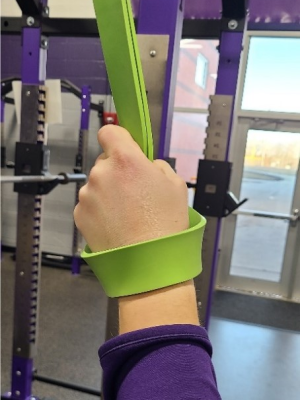
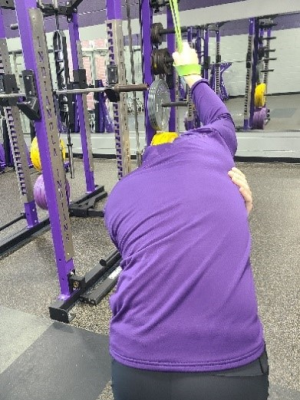
2.) Get to know your foam roller better.
If you haven’t used a foam roller before, you need to try it out. Rolling out your thoracic spine is a great way to add a thoracic extension to your spine if you are constantly hunched over. Position yourself in a “sit-up” position with your roller behind you and parallel to your hips. Place your shoulder blades against the roller, and with your hands supporting your neck, chin tucked, and hips low, walk your body up and down over the foam roller. Do this slowly and take time to feel tight areas in your back. As you roll over the foam, try to let out a light exhale, and you might even feel some small pops, followed immediately by tension relief. Keep the roller between the top of your shoulder blades and the bottom of your rib cage. Try 8 to 10 repetitions.
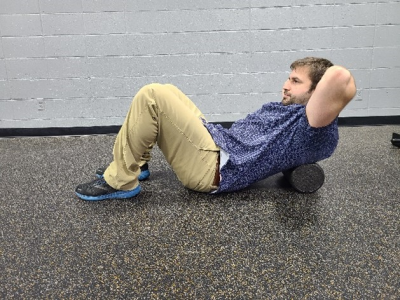
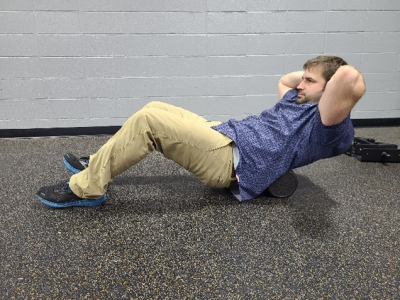
3.) Get in touch with your inner animal.
Now that your lats are relaxed and your thoracic spine can move better, it is time for the cat-cow stretch. This brings movement to the thoracic spine needed for overhead skills. Place yourself on all fours and as you inhale a breath, bring your chin down to your chest and lift your upper back to the sky (cat). On your exhale, lift your chin to the sky and bring your belly down to the ground (cow). Make sure not to feel this in your low back. Try 10 to 15 reps. Add in the corresponding onomatopoeias, and will surely have a good time!
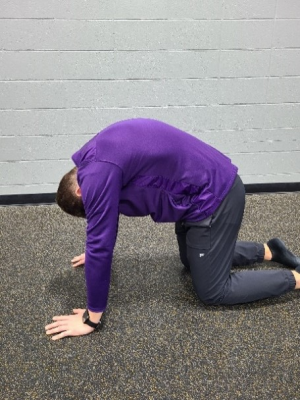
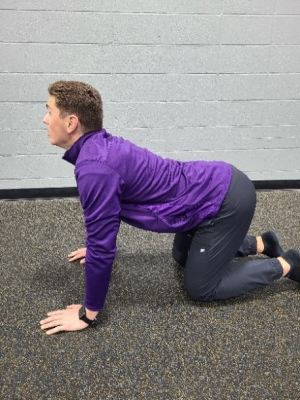
4.) Prime your rotator cuff.
While adding movement is great, we must also get our rotator cuff ready to work. For the Forearms-up exercise, lie on your stomach with your arms and elbows bent at 90 degrees and palms down. Keeping your elbows “glued” to the floor, lift your forearms to the sky as high as you can. Hold at the top for 3s seconds, then slowly come back down. Perform at least 10 of these or until you feel a good burn on the back underside of your shoulders. This will specifically target the infraspinatus and teres minor, crucial rotator cuff muscles responsible for keeping your shoulder in a healthy position as you move overhead.
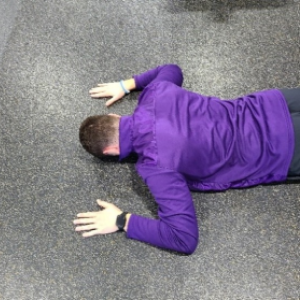
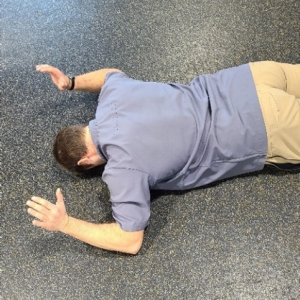
5.) Add in some rotation!
The thoracic spine has to rotate effectively to allow throwing or hitting a ball overhead. As stated eariler, when the lats can become tight, this can also lead to poor rotation throughout the thoracic spine. This mobility drill is great for adding some much-needed range of motion before throwing.
Before getting started, it is best to have a little over-pressure on your shoulders; this allows the rotator cuff to engage throughout the movement. A 10-pound dumbell works the best, but it’s not a must if you don’t have one.
You will start in a half kneel position, holding the dumbell at the shoulder position in the hand of your forward leg. Keeping a good upright posture, rotate back and over your front leg, using your opposite arm to brace off your front leg. You may feel a light stretch in your back hip flexor and the upper back of your bracing arm. You also may feel a slight stretch under your shoulder blade of the forward leg. Hold for no more than 15s, then switch legs and rotate to the other side. Perform 2 to 3 rounds on each side. Try to gently increase the range of motion each time comfortably.
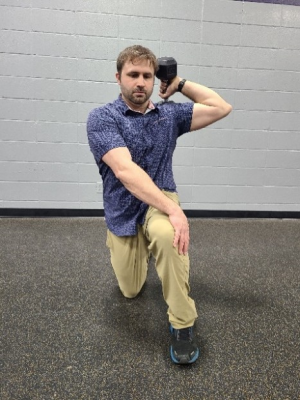
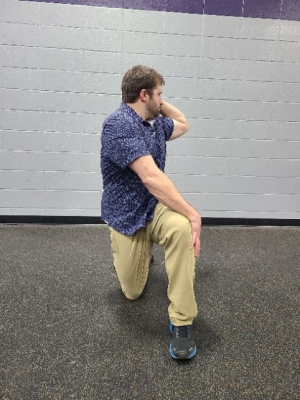
6.) Get your scapula to move!
Finally, in order to have strong functional movement overhead, our scapula (shoulder blades) must upwardly rotate in unison with our humerus (arm). This primer, called the Banded Field Goal, is good for just that. Ever watch the football officials after a field goal is made? You are going to do the same movement with a mini band.
Take a light mini-loop band and place it around your forearms. Assume a low field goal position with your arms, keeping tension in the band as you hold your arms close to your chest. With tension kept in the band, slowly straighten your arms overhead as if you were signaling a field goal being made. Take about 3 seconds to go through the range of motion, hold for 2 seconds at the top, then come back down in the same cadence you went up. The key is always keeping tension in the band. This will get your scapula and humerus moving together nicely. Try 10 of these; you should feel a great burn on the outsides of your shoulders and prime your movement pattern to get ready to play.
Once completing these six primers, slowly start into your overhead routine. If you are throwing, gradually build up your velocity over the course of 10 throws. If you are hitting a volleyball, start light and increase intensity. With your upper back and rotator cuff ready to go, you should have a highly competitive and injury-free performance session!
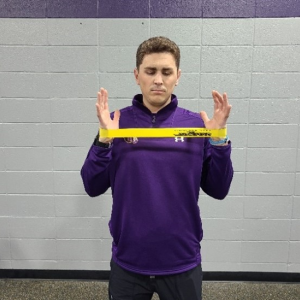
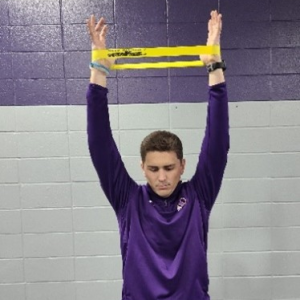
Keep Training
Try to incorporate these warm-up stretches into your training to enhance your performance and reduce injury risk. If you have further questions or would like to work on individual deficits, contact an Athletico near you to set up a free assessment. Free assessments are available in the clinic and virtually through our Telehealth platform.
*Per federal guidelines, beneficiaries of plans such as Medicare, Medicaid, Tricare, VHA and other federally funded plans are not eligible for free assessments.
The Athletico blog is an educational resource written by Athletico employees. Athletico bloggers are licensed professionals who abide by the code of ethics outlined by their respective professional associations. The content published in blog posts represents the opinion of the individual author based on their expertise and experience. The content provided in this blog is for informational purposes only, does not constitute medical advice and should not be relied on for making personal health decisions.
